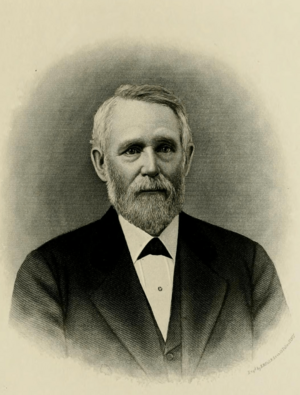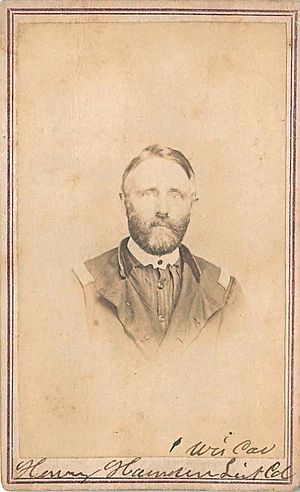Henry Harnden facts for kids
Quick facts for kids
Henry Harnden
|
|
|---|---|

Engraving by H. B. Hall & Sons
|
|
| Member of the Wisconsin State Assembly from the Jefferson 4th district |
|
| In office January 1, 1866 – January 7, 1867 |
|
| Preceded by | William P. Forsyth |
| Succeeded by | Jost D. Petrie |
| Personal details | |
| Born | March 4, 1823 Wilmington, Mass., U.S. |
| Died | March 17, 1900 (aged 77) Madison, Wisconsin, U.S. |
| Resting place | Forest Hill Cemetery, Madison, Wisconsin |
| Political party | Republican |
| Spouse |
Mary A. Lightner
(m. 1848–1900) |
| Children |
|
| Military service | |
| Allegiance | United States |
| Branch/service | United States Volunteers Union Army |
| Rank |
|
| Unit | 1st Reg. Wis. Vol. Cavalry |
| Battles/wars | American Civil War |
Henry Harnden (born March 4, 1823 – died March 17, 1900) was an American sailor and politician. He was also a pioneer in the state of Wisconsin. During the American Civil War, he was an officer in the Union Army. He led a cavalry group from Wisconsin that helped capture the Confederate president, Jefferson Davis. After the war, he was given an honorary rank of brigadier general. He also served one term in the Wisconsin State Assembly, representing Jefferson County.
Contents
Early Life and Adventures
Henry Harnden was born in March 1823 in Wilmington, Massachusetts. He went to school there until he was 18. Inspired by his uncles who were sailors, he left school to work on a merchant ship. For five years, he sailed to many places. He visited the west coast of Africa and sailed around Cape Horn. He also traveled along the entire west coast of South America and Mexico. Later, he explored the Caribbean Sea and the Gulf of Mexico.
Witnessing the Mexican-American War
While working in the Gulf of Mexico, the Mexican–American War began. Henry saw General Zachary Taylor land his army. He helped carry wounded American soldiers back to New Orleans after the Battle of Palo Alto. Soon after, he got sick and went back home to Massachusetts to get better.
Gold Rush and Moving to Wisconsin
After recovering, Henry worked as a store clerk for several years. In 1850, he traveled across the country to California. He wanted to join the California Gold Rush. His journey was tough, and he faced challenges from Native American groups. He didn't find gold, so he quickly gave up. To return home, he worked as a sailor again, sailing from California to Boston.
In 1852, Henry looked for farmland in the new state of Wisconsin. He settled in the town of Sullivan, in Jefferson County, Wisconsin. He soon stopped farming and started a lumber business. He built and managed a sawmill powered by steam.
Civil War Service
When the American Civil War started, Henry Harnden gathered his sawmill workers. He told them the mill would close. He said he would join the Union Army and encouraged them to do the same. All of his workers decided to enlist. Henry joined as a private in a cavalry group forming in Ripon, Wisconsin, in 1861. This group later became the 1st Wisconsin Cavalry Regiment. Henry was promoted to sergeant, then to captain of Company L.
Fighting in Missouri
The regiment officially joined the army in March 1862. They went to St. Louis for duty in the western part of the war. They were sent to Cape Girardeau, Missouri. Their colonel, Edward Daniels, took command of the area.
Through the spring and summer of 1862, they scouted and fought against rebel groups in southeast Missouri. Henry played an important role. He led 100 men to Scatterville, Arkansas. There, he surprised about 125 rebels, killing eight and capturing fourteen. They also took many rifles, horses, and mules.
Henry was later sent ahead to take control of Cache River Bridge. He captured ten more rebel soldiers and a high-ranking officer. The regiment then captured a rebel steamship. By late September, many soldiers were sick. Captain Harnden was in charge of the regiment, with only a few officers and 60 men healthy enough to fight.
In the spring of 1863, Confederate general John S. Marmaduke attacked Union forces in southeast Missouri. The 1st Wisconsin Cavalry helped defend at the Battle of Cape Girardeau. They held their ground until Union help arrived. Then, they led the chase after the enemy.
Battles of Chickamauga and Chattanooga
In April 1863, Henry's regiment joined the Army of the Cumberland. They arrived in Nashville, Tennessee, in early May. They fought against Confederate general Braxton Bragg in middle Tennessee. In September, the regiment fought in the Battle of Chickamauga. They battled enemy cavalry for several days. After a Union defeat, they had to retreat to Chattanooga.
After the retreat, Bragg's army surrounded the Union forces at Chattanooga. They hoped to make them surrender by cutting off supplies. The 1st Wisconsin Cavalry was sent to keep the supply lines open. They chased Confederate raiders and caught their rear guard. They captured 11 Confederate prisoners and freed Union prisoners. They continued the chase and won a tough fight. They killed 50 enemies and captured 42 more.
After a short rest, they chased the rebel cavalry into Alabama. They fought for three months along the Tennessee–Alabama border. This was part of the Chattanooga campaign. They spent the winter in southeast Tennessee. In March 1864, they received 354 new recruits.
Atlanta Campaign and Injuries
On May 3, 1864, the 1st Wisconsin Cavalry joined General Sherman's Atlanta campaign. They fought many skirmishes in northern Georgia. At the Battle of Rocky Face Ridge, their colonel was captured. Several other officers were wounded. After the Battle of Resaca, Henry was again in command of the regiment.
Just a few days later, at the Battle of New Hope Church, Henry led a charge. He was badly wounded when a pistol shot shattered his right arm. He was sent to a hospital in the north to recover. During this time, he was promoted to major.
Wilson's Alabama Campaign
Henry spent most of 1864 recovering from his injury. He returned to his regiment around the time of the Battle of Nashville. He joined General James H. Wilson in chasing Confederate forces into northern Alabama. On January 6, 1865, Henry was promoted to lieutenant colonel. He took command of the regiment.
During the Battle of West Point, Henry led a group of cavalry. They stormed and captured Fort Tyler. Here, Henry was wounded again, this time shot in the thigh. However, he was only briefly unable to fight.
Capturing Jefferson Davis
As the Union gained control of Alabama and Georgia, General Wilson chose Henry to lead a group. Their mission was to stop Confederate president Jefferson Davis from escaping. Near Dublin, Georgia, Henry learned about a wagon train. He believed it carried the Confederate president. He split his group and quickly chased the train for several days.
Near Abbeville, Georgia, Henry met Colonel Benjamin D. Pritchard. Pritchard's 4th Michigan Cavalry Regiment was guarding the area. Henry told Pritchard about the wagon train. The next morning, Henry's forces approached the wagon. They came under fire and fought back. They soon realized they were fighting members of the 4th Michigan Cavalry, who had moved ahead of them. While this was happening, other forces from the 4th Michigan Cavalry captured Jefferson Davis.
An investigation later decided that both regiments deserved credit for the capture. It also found that Henry was not to blame for the fighting between the two Union groups.
Henry left the army on July 19, 1865. He was given two honorary ranks: first colonel, then brigadier general. President Andrew Johnson nominated him for brigadier general in January 1866. The United States Senate approved it in March 1866.
Life After the War
After the war, Henry Harnden returned to Madison. He served one term in the Wisconsin State Assembly in 1866. He also held several government jobs, including U.S. Assessor and U.S. Collector of Internal Revenue. In 1899, Henry became the Commander of the Wisconsin Department of the Grand Army of the Republic. This was a group for Civil War veterans. He held this role until he died.
Henry Harnden died from pneumonia at his home in Madison, Wisconsin. He was buried in the historic Forest Hill Cemetery.
Because of the arguments about the capture of Jefferson Davis, Henry wrote a short book. It was called The Capture of Jefferson Davis, published in 1898.
Family Life
Henry Harnden was the son of Jonathan and Rhoda Harnden. His family came from Puritan settlers in the Massachusetts Bay Colony. His ancestors settled in Andover, Massachusetts, in 1640. His grandfather and great-uncle fought in the American Revolutionary War. One of his uncles was wounded in the War of 1812. Two of his brothers and thirteen nephews also served in the Union Army or Navy during the Civil War.
He married Mary A. Lightner in December 1848. Mary was the daughter of a lawyer from Boston. They had four daughters together. His wife and all four daughters were still alive when he passed away.
Published Works
- Harnden, Henry (1898). The Capture of Jefferson Davis; a narrative of the part taken by Wisconsin troops. Madison, Wisconsin. https://babel.hathitrust.org/cgi/pt?id=uc2.ark:/13960/fk3tt4g09q.
See also
- List of American Civil War brevet generals (Union)
Images for kids



